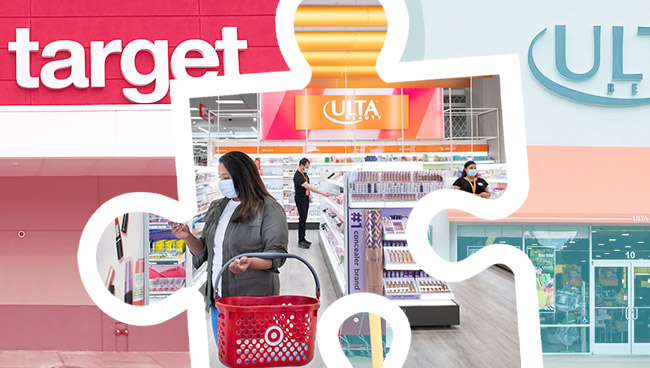More big retailers are exploring alliances, with the anticipation that doubling up will double the cachet, more than double the size of the shopper basket – and create a second reason to come into the store. WSL sent its Retail Safari® scouts out to see what works and does not toward this bigger-basket goal, and have gathered seven instructional examples.
Considering a Retail Partnership? Consider These Examples.
Nearly seven in 10 shoppers in our How America Shops® survey choose where to shop based on how affordable, available and fast it is to find what they need.
The synergies of combining two retail initiatives – doubling up retail brands under one roof or web site – can accomplish this, but only if the partnership is executed well enough to meet this new shopper path.
In the last few months we’ve seen a rise in these partnerships, such as those between Kohl’s and Sephora, Target and Ulta, Walmart.com and Gap Home, Kohl’s and WW and HyVee and Johnson Fitness & Wellness. We sent our Retail Safari® explorers out to investigate these store-within-store (or site-within-site) partnerships. Here, we share the highlights.
What Works: Wellness, Assortment and Category Growth
Keeping in mind the goal is to bring shoppers into the store/website and increase sales for both, our experts specifically sought out what makes them work, and what risks their success.
Overall, we found the retail partnerships we explored achieved this goal, largely by expanding categories and assortments – notably in wellness.
Here are a few examples of partnerships working well, from our “Power Of Two” Retail Safari®.
Partnering for Wellness:
- Premium gym equipment is popping up at the supermarket as well, through Hy-Vee’s partnership with Johnson Fitness & Wellness, one of the best-rated national fitness suppliers. The alliance extends Johnson’s reach to a high-frequency store, while Hy-Vee delivers a surprise wellness experience.
- Kohl’s approach to wellness involved a January partnership with WW (formerly Weight Watchers). At 50 pop-up locations, it brought WW members into Kohl’s stores for their weekly meetings, and encouraged Kohl’s employees to participate.
Adding Brand Cachet and Shopper Convenience
- Ulta at Target, and Sephora boutiques in Ulta, present eye-catching, standalone environments that provide shoppers of each store new access to higher-end brands, including department store brands. The added win for shoppers: they get more done on one trip.
- Target realized it was not maximizing its alignment with Apple so it upgraded the section to carry a more “Apple-esque” brand feel, with space to test products, assisted by Apple-trained techs.
- Even the giant Walmart has found a partnership by being the first to add the well-known Gap fashion brand to its home assortment. Gap Home will likely surprise Walmart shoppers, and attract new ones, while expanding Gap into the lucrative home fashion category.
- And in a truly reinventive move, Saks Fifth Avenue has converted underperforming space at some stores to office rentals, through a deal with WeWork. Members of SaksWorks get easy access to gyms, cafes, wellness clubs and – importantly – the Saks showroom.
The Challenges: Location, Location …
A key challenge to these alliances is scaling up to the full chain.
- These partnerships have limited footprints. Ulta, now in only about 100 Target locations, plans for 800, but allocating space and staff could take time. The re-designed Target/Apple model is in just 17 or so stores. And the Kohls’ limited partnership with WW likely had a short-term effect.
The shoppers’ mindset. Some of the product extensions may require a shift in shopper thinking.
- Typical Hy-Vee shoppers on stock-up trips may not have the time to or be dressed for, testing gym equipment. (But they could add it to their future-trip list.)
- And moving one’s home office to SaksWorks may just be too tempting for those who couldn’t resist spending their earnings on new shoes and bags.
What’s Working
- In both the Ulta–Target and Sephora-Kohl’s alliances, they recognize the shopper they are targeting. Sephora offers lots of $20-and-under choices for the sales-driven Kohl’s shopper, and Ulta is bringing department store brands to Target shoppers.
- Target learned that in order to maximize an alliance, it must duplicate the personality of the brand, in this case Apple.
Even with challenges, what matters is that these large companies have put individual egos aside to come together to generate more traffic, increase sales and give shoppers what they want – more choices that are affordable, available and fast.
Are you looking for your partner? Then we’re here to give you the shopper’s point of view.
Anticipating shoppers’ needs wants and values starts with How America Shops® consumer research and our WSL Retail Safari® tours. You can access our “Power of Two” Retail Safari® with images and commentaries for the partnerships mentioned here and much more.


